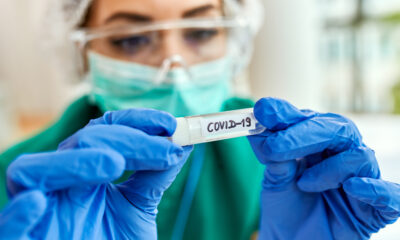
OpEds

Milligram of prevention worth a kilogram of cure
Published
2 years agoon
Once again, our team of doctors find ourselves treating scores of patients with flu, or influenza A, to be more precise. The patients are acutely unwell, and the treatment is limited. Thankfully, the average recovery is good.
While I’m not anxious about a June spike of influenza cases across our community because it’s a phenomenon we see annually, my mind keeps drifting to the year that we didn’t see a single case of influenza in winter in Johannesburg. The winter of 2020, four months after the COVID-19 pandemic arrived on our shores, had absolutely no flu – a novel experience for every doctor.
The COVID-19 pandemic certainly taught the medical world humility. With its hi-tech diagnostic techniques, advanced life-support knowledge, and developed treatment modalities, it was left dumbstruck by a simple meniscal zoonotic virus – a clear lesson that G-d runs the world, not mankind. As much as this requires us to put our lives into the hands of the divine and simply trust, there are equally strong lessons emerging from COVID-19 of a preventative-medicine mindset.
The Commonwealth Fund in the United States (US) released a study in April 2022 stating that COVID-19 vaccinations up until March 2022 had prevented 2.2 million deaths, 17 million hospitalisations, and 66.1 million additional infections in the US. This is in a country that has had one million deaths and 4.8 million hospital admissions. These numbers are formidable.
In spite of the ongoing pushback by anti-vaxxers, the data speaks clearly that vaccines save lives. It’s a feather in the cap for preventative medicine. In 2020, our COVID-19-threatened community embraced the concept of vaccination against various diseases, and almost all of us elected to have flu shots. The 2020 flu shots, coupled with masks and social distancing, “eradicated” flu that year. Lives were saved, and significant suffering was prevented.
I’m astounded to see that two years later, flu-vaccination rates in this same community are probably down to where they were pre-pandemic, and the disease burden of influenza is right back up. So, my mind delves into other areas of primary care preventative medicine and the health-seeking behaviour we employ (or choose not to) regarding its offering.
The Healthcare Cost Institute estimated childhood immunisation to have initially dropped 60%, mammograms 80%, and colonoscopies 90% in the first 18 months of COVID-19. As the threat from COVID-19 has settled, these numbers have improved, but we’re nowhere near pre-pandemic levels of preventative screening.
Even pre-pandemic levels left much to be desired. Anecdotally, my practice has seen several patients with serious diseases recently that could have been prevented had the patient engaged in appropriate proactive preventative checks.
So, what are the preventative checks in a post-COVID-19 world that we need to take seriously?
Blood pressure. Hypertension is the number one cause of cardiovascular related deaths in the world. It takes two minutes to have your blood pressure checked. All adults over 18 old should check it annually.
Lipid panel. One in six people have high cholesterol, which contributes greatly to strokes and heart attacks. Testing is a simple blood test, ideally a full lipid panel not just a total cholesterol. All adults over 18 should have this done annually.
Fasting glucose. There are 550 million people with diabetes worldwide. Two hundred and forty million are undiagnosed. Often the initial years of diabetes are asymptomatic. Untreated diabetes causes heart attacks, strokes, kidney failure, blindness, and amputations. A simply fasting finger prick will raise appropriate red flags and expose the need for treatment. All adults over 18 should have this done annually.
STDs and HIV. One in every seven South Africans is HIV positive. HIV infection is fully controllable for a long and healthy life. All teenagers and adults at risk should be tested annually.
Pap smears. This is a simple vaginal (cervical) test which can be done at a GP. When this test is sent off to the laboratory for HPV (human papilloma virus) testing as well, it’s highly effective at diagnosing precancerous conditions and high-risk states. All women two years after becoming sexually active or from the age of 21 until the age of 65 every 18-24 months.
BMI (body mass index). This is a calculation of your weight for your height (kg/m2). The World Health Organisation estimates that 2.8 million people die a year simply from being overweight. You need a tape measure and a scale to calculate. All people annually.
Mammograms. One in 28 women in South Africa are at risk of breast cancer. Your doctor should teach you how to self-examine your breasts monthly from adolescence. All women annually over 40, and individuals with family history over 30 years old. High-risk individuals annually.
Bone density scans. Recommended for men and women, but particularly postmenopausal women over 65. All individuals over 65 every two years if initial scores are low.
PSA (Prostate Specific Antigen). A simple blood test for males 45-70 years old to detect early prostate cancer. In higher-risk individuals, this needs to be accompanied by a rectal finger exam. Males over 45 annually.
Colonoscopies and gastroscopies. A day procedure under sedation, done in a hospital. All individuals 45-75 years old every five years.
Stool occult blood. A lab stool test to identify individuals at risk of colon cancer who may not be able to access scopes or in between scopes. All individuals over 45.
Skin mole checking. To detect early signs of skin cancers. You should check your skin for new, unusual moles and if any doubt, consult your doctor. Where available, dermatology mole mapping every three years. All individuals between 20-40 years old every three years, and over 40 annually.
ECG. A simple tracing of your heart that’s effective in detecting ischaemia, arrythmias, and some structural heart changes. Where available, every two years from 45. One childhood screening ECG where available.
Few people are committed to every one of these checks on this list. I have encountered several patients who are scrupulous about some of them and neglectful about others, who unfortunately became ill unnecessarily. Read the list again, and speak to your doctor if you’re not fully screened.
Let’s reflect on the past 2.5 years, and realise that we haven’t become wonderful at curing COVID-19, but we have become wonderful at preventing it: let’s employ preventative medicine into each of our lives.
- Dr Daniel Israel is a family practitioner in Johannesburg.










